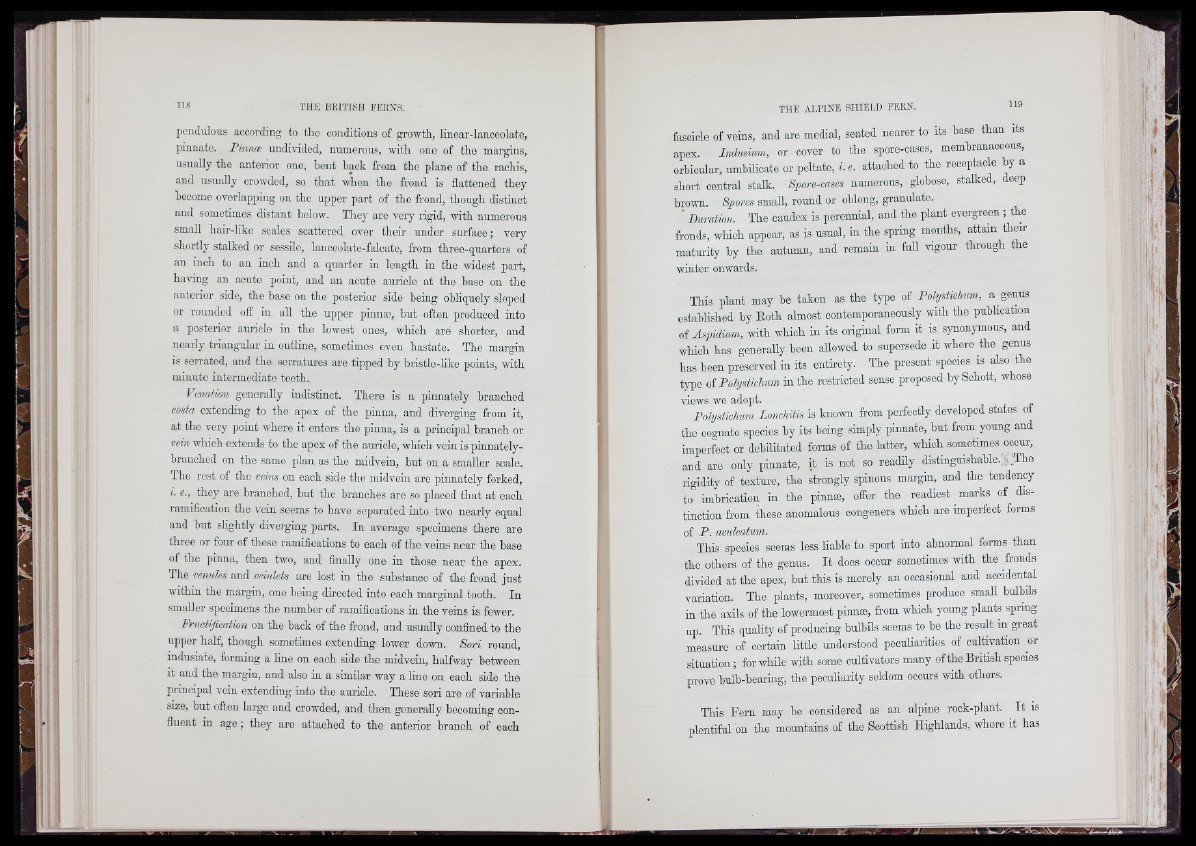
pciiJuloiis according- to the conditions of groivth, linear-lanceolate,
pinnate. Pimm niidividcd, numerous, with one of tho margins,
usually the anterior ono, bent back from tho plane of the raohis,
and usually crowded, so that when tho frond is flattened they
become overlapping on tho upper part of the frond, though distinct
and sometimos distant below. They are very rigid, with numerous
small hair-like scales soattorod over their under surface ; very
shortly stalked or sessile, laiioeolato-faloato, from three-quarters of
an inch to an inch and a quarter in length in the -widest part,
having an acute point, and an acute auricle at the base on the
anterior side, the base on the posterior side being obliquely sloped
or rounded off in all the upjier pinnie, but often produced into
a posterior auricle iu the lowest ones, which are shorter, and
nearly triangular in outline, sometimes even hastate. Tho margin
is serrated, and the serratures are tipped by hristle-hke points, with
minute intermediate teeth.
Venation generally indistinct. There is a pinnately hranohod
costa extending to the ajjex of the pinna, and diverging from it,
at the very point where it enters the pinna, is a principal branch or
vein which extends to the apox of the auricle, which vein is pinnately-
branchod on tbo same plan as the midvein, hut on a smaller scale.
The rest of the veins on each side tho midvein are pinnately forked,
i. e., they are branched, but tho branches are so placed that at each
ramification the vein seems to have separated into two nearly equal
and hut slightly divei-ging parts. In average specimens there are
three or four of these ramifications to each of the veins near the base
of the pinna, then two, and finally one in those near the apex.
The vemde¿ and veinlets are lost in the substance of the frond just
within the margin, one being directed into each marginal tooth. In
smaUer specimens the number of ramifications in the veins is fewer.
Fructification on the hack of the frond, and usually confined to the
upper half, though sometimes extending lower down. Sori round,
indusiate, forming a line on each side the midvem, halfway between
it and the margin, and also in a similar way a line on each side the
principal vein extending into the auricle. These sori are of variable
size, but often large and crowded, and then generally becoming confluent
in age ; they are attached to the anterior branch of each
fascicle of veins, and are medial, seated nearer to its base than its
apex. Indusium, or cover to the spore-cases, mcmhranaoeous,
orbicular, umbilicato or peltate, i. e. attached to tho receptacle by a
short central stalk. Spore-cases numerous, globose, stalked, deep
brown. Spores small, round or oblong, granulate.
' Duration. Tho caudex is perennial, and tho plant evergreen ; the
fronds, which appear, as is usual, in the spring months, attain their
maturity by the autumn, and remain in full vigour through the
winter onwards.
This plant may be taken as the type of Polystichum, a genus
estabUshed by Roth almost contemporaneously with the pubhoation
of Aspidium, with which in its original form it is synonymous, and
which has generaUy been allowed to supersede it where the genus
has been preserved in its entirety. The present species is also the
typo of Polystichum in the restricted sense proposed hy Schott, whose
-views wo adopt. , , r r
Polystichum Lonchüis is known from perfectly developed states ot
the cognate species by its being simply pinnate, but from young and
imperfect or debilitated forms of the latter, which sometimes occur,
and are only pinnate, it is not so readffy distínguishable.7 . The
rigidity of texture, the strongly spinous margin, and the tendency
to imbrication in the pinnæ, offer the readiest _ marks of distinction
from these anomalous congeners which are imperfect forms
of P . aculeatum.
This species seems less liable to sport into abnormal forms than
the others of the genus. I t does occur sometimes with the fronds
divided at the apex, but this is merely an occasional and accidental
variation. The plants, moreover, sometimes produce small bulbils
in the axils of the lowermost pinnæ, from which young plants spring
up. This quality of producing bulbils seems to bo the result in great
measure of certain Httle understood pecuHarities of cultivation or
situation ; for while with some cultivators many of the British species
prove hulb-bearing, the peoidiarity seldom occurs with others.
This Fern may he considered as an alpine rock-plant. I t is
plentiful on the mountains of the Scottish Highlands, where it has
,;|-
:
'I
4
i- ■
V Ó I
: . ' li